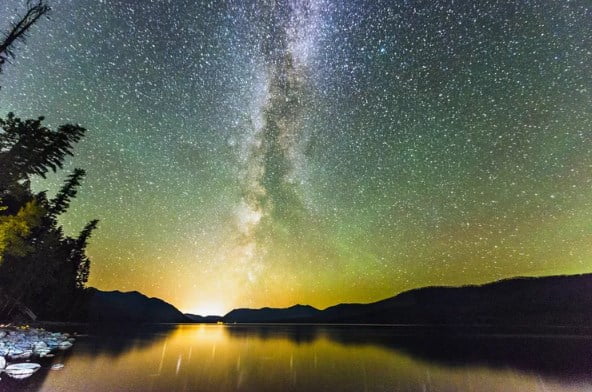Affectionately known as “Big Sky Country,” Montana’s glorious blue skies seemingly stretch forever, yet the heavenly expanse we love truly shines at night. Although nearly 80 percent of the United States cannot see the Milky Way, Montana’s dark skies are one of the last places to experience the stars as everyone once could.
But the truly dark skies belong to the eastern half of the state where you only need to travel 5 to 10 miles outside of the small towns to be immersed in the starry heavens. Traveling off the beaten path to these small towns and remote places to experience the night sky is the best way to avoid the crowds and immerse yourself in the stars.

Medicine Rocks State Park
Rock arches and perforated sandstone pillars, some standing 80 feet tall, adorned with ancient petroglyphs and signatures from the 1800s are proof that this area has called to people for eons.
Camp at the 12 campsites (first come, first serve) at Medicine Rocks State Park for the best opportunity to view the night sky as long as you can stay awake, or opt to travel the 12 miles south to the small town of Ekalaka where you can find lodging and restaurants. During the day, be sure to visit the Carter County Museum which boasts excellent exhibits about dinosaurs, First Peoples’ heritage, and Montana homesteading.
Brush Lake State Park
Tucked into the northeastern corner of the state, swimming and watersports are popular on the 2,800-acre lake during the day. Brush Lake is also an ideal place to look at the stars at night and is another park under consideration for a dark sky designation. There are reservable sites at the campground, as well as lodging and restaurants in Plentywood or Medicine Lake, both of which are roughly 25 to 30 miles from the park.
Charles M. Russell National Wildlife Refuge (CMR)
Once you venture beyond the dam into the rugged breaks, the night sky is practically limitless. Hell Creek State Park along the southern side of Fort Peck Reservoir has an exceptional dark sky rating making it an excellent stargazing destination. It even has a large campground with electrical hookups.
There is a multitude of more primitive camping opportunities throughout the CMR, including at the James Kipp Recreation Area near the Slippery Ann Elk Viewing Area, which is the place to be in September and October when the bull elk put on a show during the rut.
While the scenery is stunning, it is important to pay attention to the weather when traveling in this area. The gravel roads are made up of a fine, natural clay base that turns to what locals call gumbo when it rains or snows making them impassable until it dries out, which thankfully is typically fairly quickly.
For less rustic conditions, many visitors use Lewistown as their home base where there are several hotels, restaurants, and places to shop. Or, on the northern end, travel the 20 miles to the larger town of Glasgow where there is also an Amtrak station for those traveling by train.
Little Rocky Mountains
The 25,000-acre island mountain range in north-central Montana along the southern portion of the Fort Belknap Reservation, light pollution is nearly non-existent in this remote region. The Montana Gulch campground in the Little Rockies is a primitive 10 spot campground, but there are cabins and other lodging options 30 miles away in the small town of Zortman.
American Prairie Reserve
Bordering several sections of the CMR, the privately owned, yet publicly available, land of the American Prairie Reserve offers exceptional star-gazing opportunities. While not a contiguous piece of property, the various units of the APR cover more than 3 million acres and typically border the CMR and the Upper Missouri River Breaks National Monument.
Although many of the roads are gravel and are best driven with four-wheel drive vehicles, the Mars Vista unit (near the James Kipp Recreation Area) and the Antelope Creek Campground are paved the entire way and are suitable for all vehicles.
There are campgrounds at Buffalo Camp in the Sun Prairie region and another at Antelope Creek, which is roughly 9 miles north of the James Kipp campground. Plus, they have off-grid yurts and a new hut along the Missouri River across from Judith Landing available to rent on the PN Unit 42 miles south of Big Sandy.
Most visitors stay in either Lewistown towards the southern end of the reserve or opt for Malta to visit the northern sections of the reserve. The Enrico Education & Science Center is in the Sun Prairie region and is available for reservations for those who wish to stay overnight and dive into a scientific experience in between stargazing opportunities.

